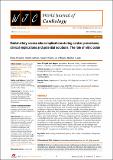Files in this item
Radial artery access site complications during cardiac procedures, clinical implications and potential solutions : the role of nitric oxide
Item metadata
| dc.contributor.author | Coghill, Emma M | |
| dc.contributor.author | Johnson, Timothy | |
| dc.contributor.author | Morris, Russell E | |
| dc.contributor.author | Megson, Ian L | |
| dc.contributor.author | Leslie, Stephen J | |
| dc.date.accessioned | 2020-01-30T10:30:05Z | |
| dc.date.available | 2020-01-30T10:30:05Z | |
| dc.date.issued | 2020-01-26 | |
| dc.identifier | 266096289 | |
| dc.identifier | 43d2ef58-b7ee-46a4-aa8d-663476d428fd | |
| dc.identifier | 31984125 | |
| dc.identifier | 000506603200003 | |
| dc.identifier | 85089764695 | |
| dc.identifier.citation | Coghill , E M , Johnson , T , Morris , R E , Megson , I L & Leslie , S J 2020 , ' Radial artery access site complications during cardiac procedures, clinical implications and potential solutions : the role of nitric oxide ' , World Journal of Cardiology , vol. 12 , no. 1 , pp. 26-34 . https://doi.org/10.4330/wjc.v12.i1.26 | en |
| dc.identifier.issn | 1949-8462 | |
| dc.identifier.other | crossref: 10.4330/wjc.v12.i1.26 | |
| dc.identifier.other | PubMedCentral: PMC6952722 | |
| dc.identifier.uri | https://hdl.handle.net/10023/19386 | |
| dc.description | Supported by the European Social Fund and Scottish Funding Council as part of Developing Scotland’s Workforce in the Scotland 2014-2020 European Structural and Investment Fund Programme. | en |
| dc.description.abstract | Percutaneous coronary intervention for the treatment of coronary artery disease is most commonly performed in the UK through the radial artery, as this is safer than the femoral approach. However, despite improvements in technology and techniques, complications can occur. The most common complication, arterial spasm, can cause intense pain and, in some cases, procedural failure. The incidence of spasm is dependent on several variables, including operator experience, artery size, and equipment used. An anti-spasmolytic cocktail can be applied to reduce spasm, which usually includes an exogenous nitric oxide (NO) donor (glyceryl trinitrate). NO is an endogenous local vasodilator and therefore is a potential target for anti-spasm intervention. However, systemic administration can result in unwanted side-effects, such as hypotension. A method that adopts local delivery of NO might be advantageous. This review article describes the mechanisms involved in radial artery spasm, discusses the advantages and disadvantages of current strategies to reduce spasm, and highlight the potential of NO-loaded nanoporous materials for use in this setting. | |
| dc.format.extent | 811084 | |
| dc.language.iso | eng | |
| dc.relation.ispartof | World Journal of Cardiology | en |
| dc.subject | Radial artery | en |
| dc.subject | Cannulation | en |
| dc.subject | Spasm | en |
| dc.subject | Nitric oxide | en |
| dc.subject | Vasodilation | en |
| dc.subject | Nanoporous material | en |
| dc.subject | RZ Other systems of medicine | en |
| dc.subject.lcc | RZ | en |
| dc.title | Radial artery access site complications during cardiac procedures, clinical implications and potential solutions : the role of nitric oxide | en |
| dc.type | Journal item | en |
| dc.contributor.institution | University of St Andrews. School of Chemistry | en |
| dc.contributor.institution | University of St Andrews. EaSTCHEM | en |
| dc.identifier.doi | 10.4330/wjc.v12.i1.26 | |
| dc.description.status | Peer reviewed | en |
This item appears in the following Collection(s)
Items in the St Andrews Research Repository are protected by copyright, with all rights reserved, unless otherwise indicated.

